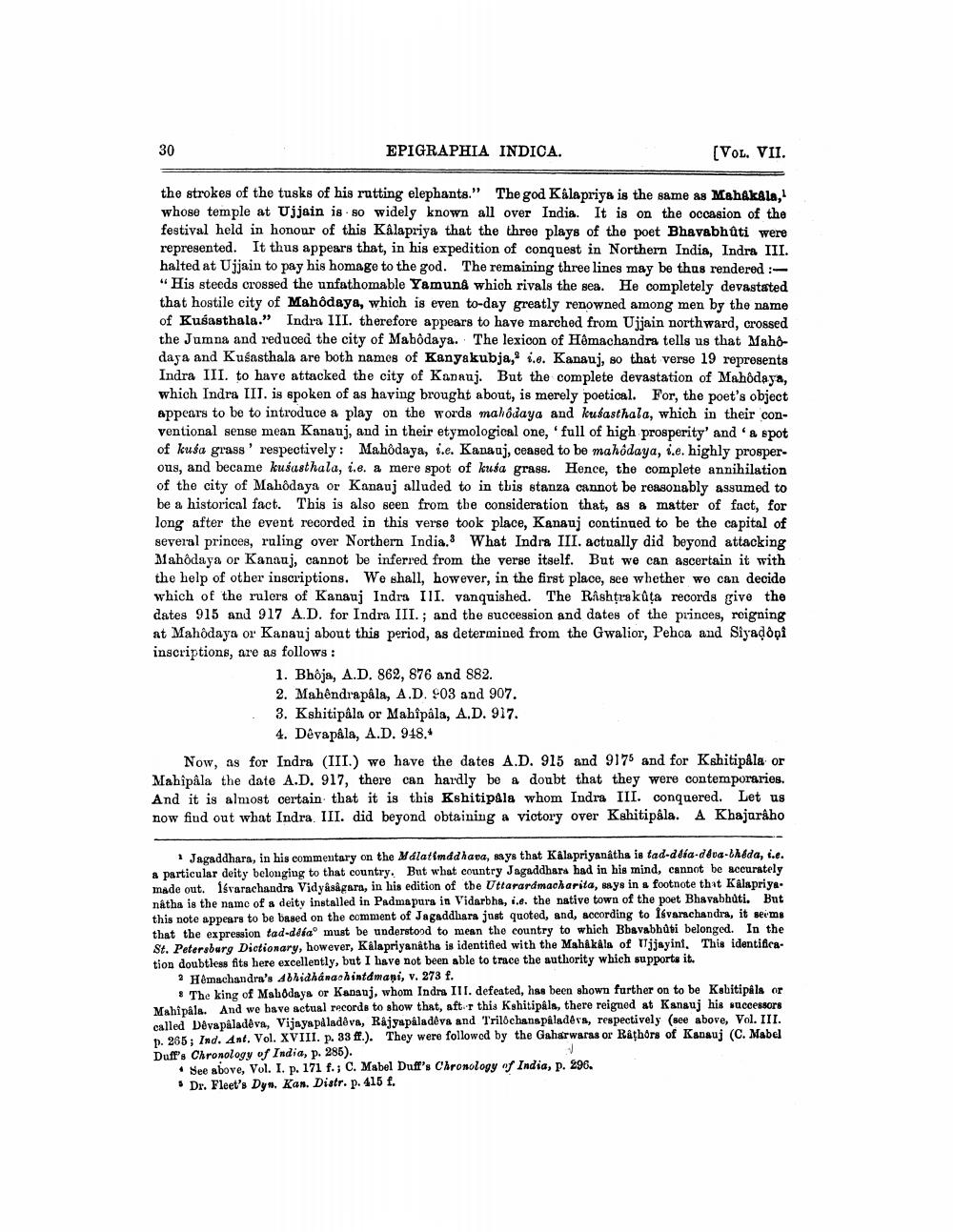________________
30
EPIGRAPHIA INDICA.
(VOL. VII.
the strokes of the tusks of his rutting elephants." The god Kalapriya is the same as Mahakala, whose temple at Ujjain is so widely known all over India. It is on the occasion of the festival held in honour of this Kalapriya that the three plays of the poet Bhavabhuti were represented. It thus appears that, in his expedition of conquest in Northern India, Indra III. halted at Ujjain to pay his homage to the god. The remaining three lines may be thus rendered :"His steeds crossed the unfathomable Yamuna which rivals the sea. He completely devastated that hostile city of Mahôdaya, which is even to-day greatly renowned among men by the name of Kuśasthala.” Indra III. therefore appears to have marched from Ujjain northward, crossed the Jumna and reduced the city of Mabodaya. The lexicon of Hômachandra tells us that Mahodaya and Kusasthala are both names of Kanyakubja, 1.c. Kanauj, so that verse 19 represents Indra III. to have attacked the city of Kananj. But the complete devastation of Mahôdaya, which Indra III. is spoken of as having brought about, is merely poetical. For, the poet's object appears to be to introduce a play on the words mahôdaya and kusasthala, which in their conventional sense mean Kanauj, and in their etymological one, full of high prosperity' and ' a spot of kusa grass' respectively: Mahôdaya, i.e. Kana uj, ceased to be mahôdaya, i.e. highly prosper ous, and became kusasthala, i.e. a mere spot of kusa grass. Hence, the complete annihilation of the city of Mahôdaya or Kanauj alluded to in this stanza cannot be reasonably assumed to be a historical fact. This is also seen from the consideration that, as a matter of fact, for long after the event recorded in this verse took place, Kanauj continued to be the capital of several princes, ruling over Northern India. What Indra III. actually did beyond attacking Mahôdaya or Kannaj, cannot be inferred from the verse itself. But we can ascertain it with the help of other inscriptions. We shall, however, in the first place, see whether we can decide which of the rulers of Kanauj Indra III. vanquished. The Rashtra kuța records give the dates 915 and 917 A.D. for Indra III.; and the succession and dates of the princes, reigning at Mahôdaya or Kanauj about this period, as determined from the Gwalior, Pehca and Siyado i inscriptions, are as follows:
1. Bhôja, A.D. 862, 876 and 882. 2. Mahendrapala, A.D. 903 and 907. 3. Kshitipala or Mahîpala, A.D. 917.
4. Dêvapåla, A.D. 948.4 Now, as for Indra (III.) we have the dates A.D. 915 and 9176 and for Kshitipala or Mahipala the date A.D. 917, there can hardly be a doubt that they were contemporaries. And it is almost certain that it is this Kshitipala whom Indra III. conquered. Let us now find out what Indra III. did beyond obtaining a victory over Kshitipala. A Khajuraho
1 Jagaddhara, in his commentary on the Malatimadhava, says that Kalapriyanatha is tad-ddia-ddva-beda, i.e. a particular deity belonging to that country. But what country Jagaddhara had in his mind, cannot be accurately made out. Isvarachandra Vidyasagara, in his edition of the Uttarardmacharita, says in a footnote that Kalapriyanátha is the name of a deity installed in Padmapura in Vidarbha, i.e. the native town of the poet Bhavabhati. But this note appears to be based on the comment of Jagaddhara just quoted, and, according to Isvarachandra, it sevms that the expression tad-ddia must be understood to mean the country to which Bhavabhūti belonged. In the St. Petersburg Dictionary, however, Kalapriyanåtha is identified with the Mahakala of Vijayini, This identification doubtless fits here excellently, but I have not been able to trace the authority which supports it.
? Hémachandra's Abhidhánachintamani, v. 273 f.
# The king of Mahôdays or Kapauj, whom Indra III. defeated, has been shown further on to be Kabitipals or Mahipala. And we have actual records to show that, aft's this Kshitipala, there reigned at Kanguj his successors called Devapaladeva, VijayapAladdva, Rajyapåladers and Trilochanapaladérs, respectively (see above, Vol. III. D. 265; Ind. Ant. Vol. XVIII. p. 33 ff.). They were followed by the Gaharwaras or Rathors of Kansuj (C. Mabel Duff's Chronology of India, p. 285).
• See above, Vol. I. p. 171 f.; C. Mabel Duff's Chronology of India, p. 296. • Dr. Fleet's Dyn. Kan. Distr. p. 415 f.




